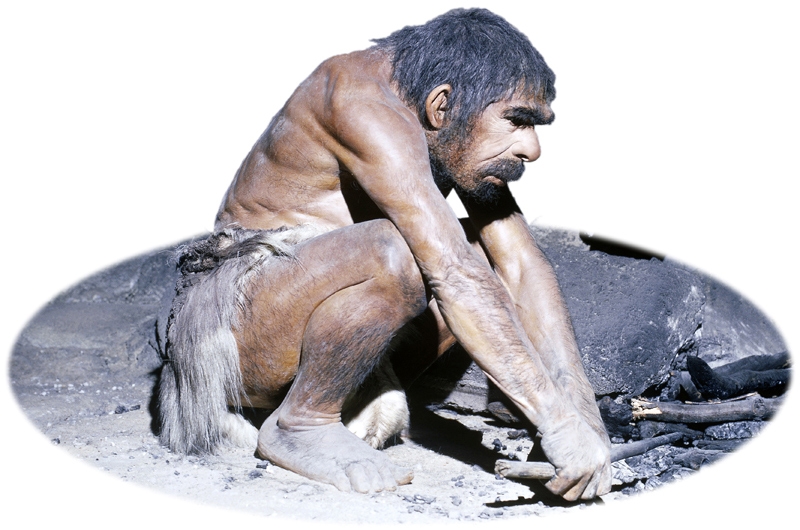The human species that today makes astounding advances in technology, and particularly in the medical field, did not exist four million years ago. In fact, hominids of that period were very different from the modern species in many ways. How did humans evolve to become today’s humans? How did Homo sapiens become so innovative? For one, they developed favorable qualities that were essential for adaptation and a thriving existence.

Homo sapiens derived from a form of early humans called Neanderthal. Unlike modern humans, characteristics of the Neanderthal included occipital buns and protruded brow ridges.1 One important facial feature of the Neanderthal was their large nose for “humidifying and warming cold, dry air” before it reached the lungs.2 Modern humans do not have this characteristic due to the fact that the Neanderthals lived in much harsher conditions. Thanks to the work of archaeologists and anthropologists, we know a great deal about the life and world of Neanderthals. The first fossils of these humans were found in France, and scholars have since called these humans Cro-Magnon. They created innovative tools from bones and antlers for hunting. This enabled them to survive and thrive in their environment. They even created artwork “in the form of decorated tools, beads, ivory carvings of humans and animals, clay figurines, musical instruments, and cave paintings.”3

Homo sapiens originated from East Africa. From there homo sapiens have migrated to all of earth’s main land masses. By taking advantage of land bridges, they have spread to Indonesia, New Guinea, Australia, and the Americas. Another contributing factor to the spreading of humans was the recent major Ice Age. The freezing of the oceans’ waters around the polar caps lowered the sea level, which exposed land bridges between land masses that were otherwise under water. For example, the connection between Calabria and Sicily had a sea level around -126 meters.4 They were able to adapt to the different environments due to their larger brain capacities, hence more intelligence. Having the knowledge that they had, they were able to create warm clothes and shelters to survive under various harsh conditions in the regions they occupied. Since they were nomadic people, there was no economic prosperity during the Paleolithic era. This was due to the fact that they never inhabited an area for a long duration of time. They were foragers; they scrapped up whatever they could find for survival, so there was no time period in which they could accumulate wealth. With that being said, that meant that there were no social classes. Instead, they lived an egalitarian lifestyle. While the men hunted, the women gathered. This method sustained their existence until the Neolithic Revolution, which domesticated both plants and animals.
The evolution of earlier hominids to Homo sapiens opened the door to a species capable of more advanced thinking about their surroundings and survival. The human race has since continued to thrive to the present. Without their innovative tools, body structures, and eventually domestication of plants and animals, Homo sapiens would not have been able to produce the advancements in technology and sciences that we have available today.
- Markus Bastir, Paul O’Higgins, and Antonio Rosas, “Facial Ontogeny in Neanderthals and Modern Humans,” Proceedings of the Royal Society B: Biological Sciences 274, no. 1614 (May 7, 2007): 1125–32. ↵
- Todd C. Rae, Thomas Koppe, and Chris B. Stringer, “The Neanderthal Face Is Not Cold Adapted,” Journal of Human Evolution 60, no. 2 (February 2011): 234–239. ↵
- “Evolution: Humans: Origins of Humankind.” Accessed September 10, 2016. http://www.pbs.org/wgbh/evolution/humans/humankind/o.html. ↵
- Fabrizio Antonioli, V. Lo Presti, M. G. Morticelli, M. A. Mannino, Kurt Lambeck, Luigi Ferranti, Catriona Bonfiglioli, et al., “The Land Bridge between Europe and Sicily over the Past 40 Kyrs: Timing of Emersion and Implications for the Migration of Homo Sapiens,” Rendiconti Online Societa Geologica Italiana, 2012. https://openresearch-repository.anu.edu.au/handle/1885/71477. ↵



99 comments
Kristina Tijerina
We have come so far in technology and medicine, and it’s super cool that we get to see how our advances happened with so many different articles about the lifestyles millions of years ago. People back then had to adapt to the harsh conditions that they lived through. It’s amazing how well they did for themselves when they had no prior technology or knowledge to go off of. They were able to figure out so much for themselves by adapting to their harsh conditions. They were even able to make warm clothes in harsh conditions, and adapt to different environments. It’s interesting that now we are able to become more innovative by going back and observing how these Neanderthals lived.
Andrew Gonzales
Its incredible to think how far we’ve come from cavemen so to speak to a complex group of individuals who can work together to solve build and create almost anything but we had to start somewhere everything does but we should never forget our “roots” because it carved the foundation for us to become what we are today and what we will become in the future
Antonio Coffee
It is amazing to see how the human body has evolved to adapt to conditions on Earth and how it has changed as time has gone on. It is truly amazing to even think that the human race has been able to keep growing and alive all these years. Humans are truly a resilient species. The thing that worries me is that the things that we will not be able to adapt to are our own greed and selfishness. I hope that in the future we can grow as a society as we grow and adapt to our environment.
Yazmin Garza
It is always crazy to think that we evolve from species that was barely discovering warm clothes and simple tools when it was around. The human race has come such a long way. Although I am grateful I live in an era of technology and no ice ages, I do wish I could experience the egalitarian lifestyle the Neanderthals experienced. It would be nice to live in a society that did not have the pressures of social classes.
Michael Leary
Very interesting article. I can recall learning about evolution from other sapiens into homo sapiens, but, not really to the extent given in the article. I found it interesting how their skull compared to modern humans with its size being much larger and how they were truly made for a more harsh environment, that perhaps, we could not survive in.
Claudia Sanchez
Love the topic! it is so interesting to learn about earlier humans that lead us to where we are now. It is so amazing to see the common traits we still have with the earliest human beings were. It is also interesting to note their human characteristics of art and music, something that connects us all the way back to the Paleolithic era.
Victoria Salazar
This was a lot of cool, new information to take in. In a lot of public primary and secondary schools, we learn about evolution but not to this extent. The land bridges were not something I had known about before. Something else I found interesting is that it was mentioned that they had larger brain capacities which allowed them to have more knowledge; it is a common misconception that the Neanderthals whom we evolved from were ignorant.
Dalton Moy
It is amazing to compare what we have today to what people in these ancient times had. The advancements made over so many years seem almost impossible when trying to compare today to ancient times. Sadly, with these changes came the introduction of social classes, which lead to corruption and inequality. On another note, it is also fascinating to learn of the different physical characteristics that early humans had, compared to now. The human body is very complex, as seen by science and the discoveries from history. So many incredible changes have occurred within the human race over time.
Bictor Martinez
It incredible how are bodies is able to adapt over time. I already had some familiar information from what we evolved from. Its also amazing that Homo sapiens were able to adapt their themselves into their environment by creating warmer clothes due to their large brain capacities. Thanks to evolving of our own bodies, our advancement in human intelligence will continue to enhance and who knows to what we will evolve to next.
Honoka Sasahara
As the author says, technology and sciences that we have today are so great that any other creatures have never got before us. I am always amazed how well improved technology and sciences are now when I hear of any new invention or discovery in the world. It is kind of unbelievable that the human race has such a long history and I am also the part of them.